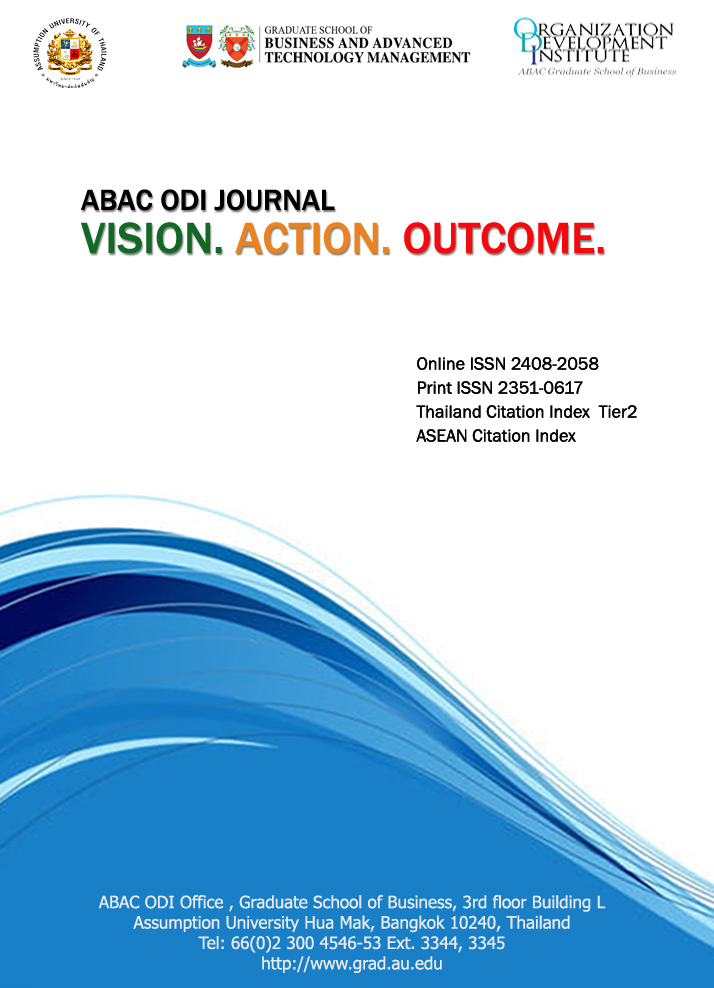To Improve Organizational Effectiveness of the Private University in China by Optimizing the Organizational Structure through Organization Development Interventions ---An Action Research Study of Zhejiang Yuexiu University of Foreign Languages (ZYUFL) in China
DOI:
https://doi.org/10.14456/abacodijournal.2021.9Abstract
This study aimed to use organization development interventions to improve the organizational effectiveness by optimizing organization structure of Zhejiang Yuexiu University of Foreign Languages in China. This current research focused on four main sub-dimensions: standardization, centralization/decentralization, specialization and integration of organizational structure. Both quantitative and qualitative methods were utilized with questionnaire, interview and observation. Quantitative data was collected to examine the change in level of standardization, centralization/decentralization, specialization and integration of organizational structure and organizational effectiveness. Qualitative data was collected to obtain in-depth understanding on the result of organization development interventions on the organization structure. The results of paired sample t-test indicated significant differences between pre- and post-ODI results in organizational structure and organizational effectiveness. Based on the Pearson Correlation results, organizational structure had a positive relationship with organizational effectiveness. The deliberated ODIs had positive effect on the level of organizational structure and organizational effectiveness. According to the results of multiple linear regressions, centralization/decentralization, specialization, and integration have an influence on organizational effectiveness. Standardization has no influence on organizational effectiveness. Further researches in the related fields were recommended in the last section.
References
Conger, J. A., & Kanungo, R. N. (1988). The empowerment process: integrating theory and practice. Academy of Management Review, 13(3), 471-482.
Cummings, T.G., & Worley, C.G. (2008). Organization Development and Change (9th ed.). Mason, OH: South-Western College Publishing.
Daft, R. L. (2010). Organization Theory and Design, Tenth Edition. South-Western, Cengage Learning
Hackman, J., & Oldham, G. (1980). Work redesign (prentice hall organizational development series).
Hage, J. and Aiken, M. (1967). Relationship of Centralization to Other Structural Properties. Administrative Science Quarterly, 12 (1), 72-92.
Hammer, M., & Champ, J. (1993). Reengineering the corporation. New York: Happer Collins.
Islami, X., Mulolli, E., & Mustafa, N. (2018). Using management by objectives as a performance appraisal tool for employee satisfaction. Future Business Journal, 4(1), 94-108.
Joris, M., Maryse, J.B., & Marco, M.(2005).Organizational structure and performance in Dutch Small Firms. Small Business Economics.2005.25(1)
Kast, Fremont E. & James, E. Rosenzweig. (1973). Contingency Views of Organization and Management. Chicago: Science Research Associates.
Kotter, J. P. (1996). Leading change. Boston: Harvard Business School Press.
Kvale, S. (1996).Interviews an Introduction to Qualitative Research Interviewing, Sage Publications,
Lawrence, P. R., & Lorsh, J. W. (1986). Organizational Structure and Design. Homewood, Ila; Irwin and Dorsey.
Lewin, K. (1952). Group decision and social change. In G. E. Swanson, T. M.Newcombe, & E. L. Hartley ( Eds.),Readings in social psychology ( 2nd ed.)
Li, F. (2005).The development, comparison and enlightens of the theories of university academic organization overseas. (Doctoral dissertation, Central china normal university).
Mao, W.P. (2013). A Research on innovation of management system of private colleges. Doctoral dissertation, Liaoning normal university.
Miller, D.,& Droge, C.(1986). Psychological and traditional determinants of structure. Administrative Science Quarterly,31(4), 539-560.
Mintzberg, H. (1979). Structuring of Organization. Prentice---Hall Inc. Englewood Cliffs,New Jersey.
Nunnaly, J. (1978). Psychometric theory. New York McGraw-Hill.
Pugh, D. S. (1973). The measurement of organization structures: does context determine form? Organizational Dynamics,1(4), 19-34.
Robbins, S.P. (1996). Organization Behavior: Concept, Controversies, Applications. New Jerser:PrenticeHall.Inc.
Robert, G. O. (1981). Organizational behavior in education. Prentice-Hall.
Senge, P. M. (1990). The Fifth Discipline: The Art and Practice of The Learning Organization. New York: Doubleday/Currency.
Withey, M., Daft, R.L. and Cooper, W. H. (1983), Measures of Perrow’s work unit technology: an empirical assessment and a new scale, Academy of Management Journal, 26, 45-63.
Zand, D. E. (1974). Collateral organization: a new change strategy. Journal of Applied Behavioral Science A Publication of the Ntl Institute,10(1), 63-89.
Zhu, X.W. (2015). Dynamic Fit: Organizational Structure Theory, Empirical Study and Case. Beijing: China, Economy & management publishing house.



